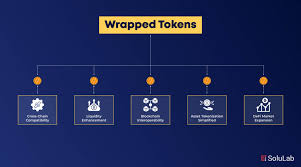In the multi-chain world of blockchain technology, wrapped tokens have emerged as a vital innovation for enhancing interoperability across decentralized ecosystems. A wrapped token is essentially a tokenized version of a cryptocurrency that exists on a blockchain other than its native network. It maintains a 1:1 peg to the original asset while enabling cross-chain functionality.
As DeFi (Decentralized Finance) applications and blockchain protocols grow in complexity and variety, wrapped tokens are solving critical issues related to liquidity, compatibility, and scalability. This article dives deep into what wrapped tokens are, how they work, their benefits, use cases, risks, and future outlook.
What Is a Wrapped Token?
A wrapped token is a digital asset that represents another cryptocurrency on a different blockchain. For example, Wrapped Bitcoin (WBTC) is a version of Bitcoin that runs on the Ethereum blockchain. It’s pegged 1:1 to BTC but compatible with Ethereum’s ERC-20 token standard.
The “wrapping” process involves locking the original token (e.g., BTC) in a smart contract or with a custodian, and minting an equivalent amount of the wrapped token (e.g., WBTC). This wrapped token can then be used on the target blockchain for various purposes such as lending, staking, or trading.
How Wrapped Tokens Work
- Custodial Process
A user deposits their native token (e.g., BTC) with a trusted custodian or through a smart contract platform like BitGo (used for WBTC). The custodian locks the asset securely. - Issuance (Minting)
Once confirmed, the custodian issues an equivalent amount of wrapped tokens (e.g., WBTC) on the destination blockchain. - Redeeming (Unwrapping)
If the user wants to get their original token back, they return the wrapped token to the custodian, which then burns the wrapped version and releases the native asset. - 1:1 Peg
The system ensures that each wrapped token is backed by the exact amount of the original asset, maintaining value integrity.
Benefits of Wrapped Tokens
- Cross-Chain Interoperability
Wrapped tokens enable users to access decentralized applications (dApps) and smart contracts on a blockchain where the original asset doesn’t natively exist. For instance, BTC holders can use Ethereum-based DeFi platforms via WBTC. - Enhanced Liquidity
By converting assets into wrapped versions, liquidity can move freely between chains, creating deeper pools and better trading experiences. - Utility Expansion
Original assets like Bitcoin, which don’t natively support smart contracts, can gain additional functionality when wrapped and used on smart contract-compatible platforms. - Transaction Efficiency
Wrapped tokens allow for faster and cheaper transactions if moved from congested networks to more scalable blockchains.
Popular Wrapped Tokens
- Wrapped Bitcoin (WBTC)
The most well-known wrapped token, allowing Bitcoin to be used on Ethereum’s DeFi platforms. - Wrapped Ether (WETH)
A tokenized version of ETH that conforms to the ERC-20 standard, allowing easier trading and DeFi integration. - Wrapped BNB (WBNB)
Enables Binance Coin (BNB) to be used in BEP-20-compatible DeFi apps on Binance Smart Chain. - Wrapped AVAX, DOT, SOL
Many major cryptocurrencies now have wrapped versions on Ethereum and other EVM-compatible chains.
Use Cases of Wrapped Tokens
- DeFi Lending and Borrowing
Users can deposit wrapped tokens into lending protocols like Aave, Compound, or Venus to earn interest or take loans. - Decentralized Exchanges (DEXs)
Wrapped tokens are traded on DEXs such as Uniswap or PancakeSwap, improving cross-chain token swaps. - Yield Farming and Staking
Yield optimizers and liquidity mining programs often accept wrapped tokens to maximize returns. - Cross-Chain Bridges
Bridges like Ren, Multichain, and Anyswap use wrapped tokens to facilitate value transfer between chains.

Risks and Challenges
While wrapped tokens are powerful tools, they are not without risks:
- Custodial Risk
If a wrapped token relies on a centralized custodian, there’s a risk of mismanagement or loss of funds. - Smart Contract Vulnerabilities
Bugs in the minting or wrapping contract can lead to exploits, de-pegging, or loss of user assets. - Peg Instability
In some cases, market panic or liquidity issues may cause a wrapped token to temporarily lose its 1:1 peg. - Regulatory Concerns
As wrapped tokens grow in use, regulators may scrutinize the custodial arrangements and their compliance status.
The Future of Wrapped Tokens
Wrapped tokens are evolving with the blockchain space. Emerging solutions such as trustless bridges, automated wrapping protocols, and native multi-chain assets are reducing reliance on custodians and making the process more secure and decentralized.
Projects like LayerZero and Cosmos IBC (Inter-Blockchain Communication) are aiming to create seamless multi-chain experiences, potentially reducing the need for manual wrapping in the future.
Nevertheless, as long as there are isolated blockchain ecosystems, wrapped tokens will remain a key tool for unifying the decentralized web, driving liquidity, and expanding asset utility across chains.
Conclusion
Wrapped tokens play a crucial role in building a more interoperable and efficient blockchain ecosystem. By enabling digital assets to traverse multiple chains, they unlock new opportunities in DeFi, NFT marketplaces, and beyond. While there are still risks to consider, the continuous innovation in this space promises a future where assets are no longer confined to their native chains.
Whether you’re a crypto trader, developer, or investor, understanding how wrapped tokens work—and how to use them securely—can enhance your participation in the ever-expanding world of Web3.








Leave A Reply